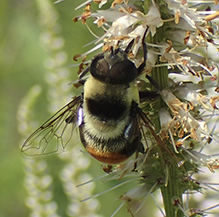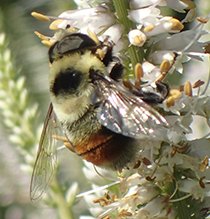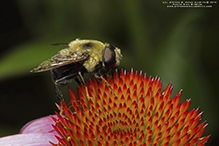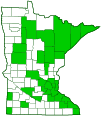orange-legged drone fly
(Eristalis flavipes)
Conservation • Description • Habitat • Ecology • Distribution • Taxonomy
Conservation Status |
|
|||||||
| IUCN Red List | not listed |
|||||||
| NatureServe | NNR - Unranked |
|||||||
| Minnesota | not listed |
|||||||
Description |
||
Orange-legged drone fly is common, hairy, medium-sized, hoverfly. It occurs throughout Canada and in the northern two-thirds of the United States. It is most abundant east of the Great Plains. It is common in Minnesota. Adults are found from mid-May to mid-October mostly in wetlands but also in a wide variety of other habitats. They feed on flower nectar. Adults are robust and 7⁄16″ to ⅝″ (11.0 to 16.1 mm) in length. They are bumble bee mimics. The head is hemispherical and slightly broader than the thorax. There are two large compound eyes on the sides of the head and three small simple eyes (ocelli) in a triangle on top of the head. The compound eyes are dark brown and are densely covered with short erect hairs. On the male they meet at the top of the head. On the female they do not. They are not spotted or banded. The face is black and shiny, and is not projected forward. The antennae are short and are inserted near the middle of the head. They are dark brown and have just three segments. At the base of the third segment there is a long, forward-pointing bristle (arista) on the upper side. The arista is bare, not feather-like (plumose). The protruding mouthpart (proboscis) is short and fleshy. The thorax is black and has three segments. Each segment has four principal exoskeletal plates, one above, one below, and one on each side. The upper (dorsal) plates, from front to rear, are the prescutum, scutum, and scutellum. The prescutum is densely covered with yellow hairs. The hair is dense enough to completely obscure the base color. The scutum is black, shiny, and mostly bare but with dense yellow hairs on the lateral margins. The scutellum is yellow and densely covered with yellow hairs. The abdomen is black and is densely covered with long erect hairs. It has five segments. The first segment is narrow and entirely black. The hair on the upper side of the basal third of the second segment is yellow, black, or more commonly a mix of the two colors. The hair on the upper side of the third segment and the outer two thirds of the second segment may be entirely black, yellow, or orange, or a mix of two or all three colors. The fifth segment is small and entirely black. The wings are clear. There is a spurious vein between the radius (R) and media (M) veins. The R4+5 vein is deeply bent (sinuous), appearing “bumped” downward in the middle. The anal cell is long and is closed near the wing margin. The marginal, R1, R5, and M2 cells are also closed. The legs are mostly black. On the hind leg, the last part of the leg (tarsus), corresponding to the foot, is orange. This is the feature that gives the insect its common name. |
||
Size |
||
Total length: 7⁄16″ to ⅝″ (11.0 to 16.1 mm) |
||
Similar Species |
||
Habitat |
||
Wetlands and a wide variety of other habitats |
||
Ecology |
||
Season |
||
Mid-May to mid-October |
||
Behavior |
||
It makes a loud buzzing sound when flying. |
||
Life Cycle |
||
|
||
Larva Food |
||
Small organisms |
||
Adult Food |
||
Flower nectar |
||
Distribution |
||||
|
Sources Telford, Horace S.. (1939). The Syrphidae of Minnesota. University of Minnesota. Minnesota Agricultural Experiment Station. |
|||
| 10/1/2022 | ||||
Occurrence |
||||
Common in Minnesota |
||||
Taxonomy |
|||
Order |
Diptera (Flies) | ||
Suborder |
Brachycera | ||
Infraorder |
Cyclorrhapha | ||
| Zoosection | Aschiza | ||
Family |
Syrphidae (Hover Flies) | ||
Subfamily |
Eristalinae (Drone Flies and Allies) | ||
Tribe |
Eristalini (Rat-tail Maggot Flies) | ||
| Subtribe | Eristalina | ||
Genus |
Eristalis (drone flies) | ||
| Subgenus | Eoseristalis | ||
Synonyms |
|||
Eristalis americanus Eristalis melanostomus Eristalis rufipilis Musca tomentosa |
|||
Common Names |
|||
orange-legged drone fly |
|||
Glossary
Arista
A large bristle on the upper side of the third segment of the antenna of a fly. Plural: aristae.
Ocellus
Simple eye; an eye with a single lens. Plural: ocelli.
Proboscis
The tube-like protruding mouthpart(s) of a sucking insect.
Scutellum
The exoskeletal plate covering the rearward (posterior) part of the middle segment of the thorax in some insects. In Coleoptera, Hemiptera, and Homoptera, the dorsal, often triangular plate behind the pronotum and between the bases of the front wings. In Diptera, the exoskeletal plate between the abdomen and the thorax.
Scutum
The forward (anterior) portion of the middle segment of the thorax (mesonotum) in insects and some arachnids.
Tarsus
On insects, the last two to five subdivisions of the leg, attached to the tibia; the foot. On spiders, the last segment of the leg. Plural: tarsi.
Visitor Photos |
|||||
Share your photo of this insect. |
|||||
| This button not working for you? Simply email us at info@MinnesotaSeasons.com. Attach one or more photos and, if you like, a caption. |
|||||
Babette Kis |
|||||
Eristalis flavipes Orange legged drone fly Eristalis flavipes, orange-legged drone fly on Culver's root. Photo taken on Barnes Prairie, Racine Co., WI on July 17, 2021. |
 |
||||
 |
|||||
Alfredo Colon |
|||||
 |
|||||
MinnesotaSeasons.com Photos |
|||||
|
|||||

Slideshows |
||

Visitor Videos |
|||
Share your video of this insect. |
|||
| This button not working for you? Simply email us at info@MinnesotaSeasons.com. Attach a video, a YouTube link, or a cloud storage link. |
|||
Other Videos |
|||
| BUMBLEBEE MIMIC FLY Eristalis flavipes foraging Rob Curtis |
|||
About
Aug 20, 2019 Eristalis flavipes ORANGE-LEGGED DRONE FLY outstanding Bumbleee mimic foraging. Skokie Lagoons FP, IL 8/5/2019. |
|||


Created: 1/8/2021
Last Updated:


